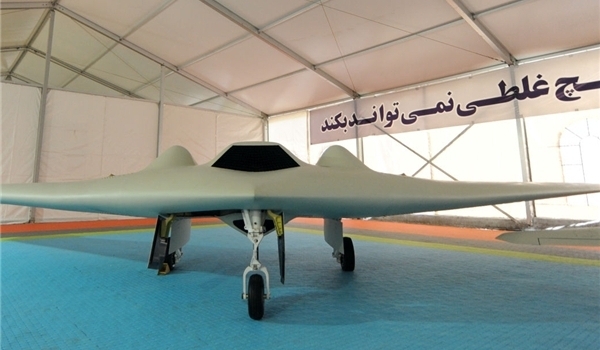 TEHRAN (FNA)- The Iranian version of the RQ-170 which has been manufactured through the reverse engineering of the US drone which was tracked and hunted down in Iran late in 2011, has been equipped by the Islamic Revolution Guards Corps (IRGC) with bombing capability to attack the US warships in any possible battle.
TEHRAN (FNA)- The Iranian version of the RQ-170 which has been manufactured through the reverse engineering of the US drone which was tracked and hunted down in Iran late in 2011, has been equipped by the Islamic Revolution Guards Corps (IRGC) with bombing capability to attack the US warships in any possible battle.This capability was revealed during Supreme Leader of the Islamic Revolution Ayatollah Seyed Ali Khamenei's Sunday visit to an exhibition of the latest achievements of the IRGC Aerospace Force. The Supreme Leader had a two-hour tour of the IRGC's Aerospace Exhibition where state-of-the-art equipment and hardware were showcased.
The advanced radar-evading US RQ-170 drone downed by the IRGC more than two years ago and its indigenized model developed by Iranian experts through reverse engineering were among the most important sections of the exhibition.
The US army uses the drone for reconnaissance missions but the IRGC Aerospace experts have equipped the Unmanned Aerial Vehicle (UAV) with bombing capabilities, enabling it to operate as a bomber aircraft against the US warships in any possible showdown between the two countries.
In December, Lieutenant Commander of the IRGC Brigadier General Hossein Salami announced that the Iranian version of the US drone, RQ-170, would be unveiled to the public soon.
�The construction of this drone will finish soon and most of the job has been done now,� General Salami told reporters on the sidelines of a conference in Tehran in December, 2013.
In relevant remarks in October, Commander of the IRGC Aerospace Force Brigadier General Amir Ali Hajizadeh said that Iran moved as much as 35 years ahead in building drone engines by reverse engineering the US drone, RQ-170 which was tracked and hunted down in Iran late in 2011.
The RQ-170 engines are the fifth generation and the engines of Iranian unmanned planes are the third generation, Hajizadeh said, adding that to produce the engine we had to spend 35 years on the project.
He said that the home-made version of the US drone RQ-170 captured by the IRGC would make its maiden flight in the near future.
In April, 2013, a senior Iranian parliamentary official announced that Iran has reverse engineered the RQ-170, adding that the Iranian version of the drone would soon have a test flight.
"The brave personnel of the Armed Forces hunted down the drone with their knowledge and science and the Americans protested immediately and called for the return of the UAV," Chairman of the parliament's National Security and Foreign Policy Commission Alaeddin Boroujerdi said in the Northern city of Rasht last April.
Iran has downed several US drones so far and Boroujerdi did not mention which one he meant, but explained, "The reverse engineering started immediately (by the Iranian experts after hunting down the US UAV) and the Iranian type of the US drone will fly in Iran's Aerospace Organization soon which shows the Islamic Republic's might and power."
Boroujerdi's remarks referred to RQ-170. The drone has special coatings and a batwing shape designed to help it penetrate other nations' air defenses undetected. The existence of the aircraft, which is made by Lockheed Martin, has been known since 2009, when a model was photographed at the main US airfield in Kandahar, Afghanistan.
The unmanned surveillance plane lost by the United States in Iran was a stealth aircraft being used for secret missions by the CIA, US officials admitted in December. The aircraft is among the highly sensitive surveillance platform in the CIA's fleet that was shaped and designed to evade enemy defenses.
Iran has downed many other US drones as well, and they have always started reproducing them after conducting reverse engineering on them.
Iran announced on December 4, 2011 that its defense forces had downed a US RQ-170 aircraft through a sophisticated cyber attack. The drone was the first such loss by the US. US officials have described the loss of the aircraft in Iran as a setback and a fatal blow to the stealth drone program.
The aircraft is among the highly sensitive surveillance platform in the CIA's fleet that was shaped and designed to evade enemy defenses.Since December, 2011, Iran has hunted down several more US drones of various types.
In January 2013, a deputy commander of the Iranian Navy announced that the country's Army had hunted two more advanced RQ type UAVs.
"The air-defense units of the Army have hunted two enemy drones," Deputy Commander of the Iranian Navy for Coordination Rear Admiral Amir Rastegari told FNA.
"These drones were from 11th series of the RQ class, and one of them was hunted in Shahrivar 1390 (August 21-September 19, 2011) and the other one in Aban (October 22-November 20, 2012)," Rastegari said, adding that the Army research center is now studying the two UAVs.
"Much of the data of these drones has been decoded by the Army's Jihad and Research Center," he said, but did not provide any further detail.
The remarks by the Iranian commander came after Iran announced on December 4, 2012 that the IRGC Navy had hunted a US UAV over the Persian Gulf after the drone violated the country's airspace.
The IRGC navy commander announced at the time that the hunted UAV was a ScanEagle drone, adding that "such drones are usually launched from large warships".
ScanEagle is a small, low-cost, long-endurance unmanned aerial vehicle built by Insitu, a subsidiary of Boeing.
Iran later reproduced its own model of ScanEagle through reverse engineering techniques.
By Fars News Agency
The Iran Project is not responsible for the content of quoted articles.











